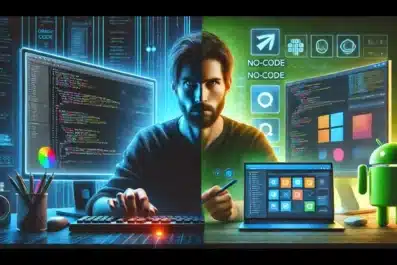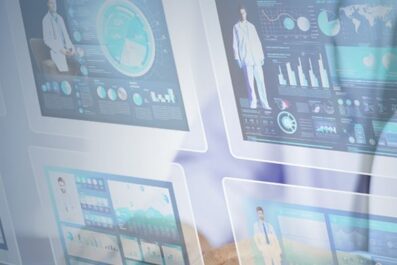Exploring the use of AR and VR in software development
Have you gone to a mall and observed a Virtual Reality zone which let you experience a computer-made world that feels nearly real?
 4 mins read
4 mins read 
Well, everyone should try it once in their lifetime.
In an era where technology become our day-to-day life part, Augmented Reality (AR) and Virtual Reality (VR) have emerged as powerful tools, revolutionizing various industries.
From entertainment to education, healthcare to engineering, the applications of AR and VR are vast and diverse. However, one area where these immersive technologies are making significant strides is in mobile app development.
In this blog post, we will delve into the exciting realm of AR and VR, exploring their use in software development and the impact they are having on the way we build and interact with digital solutions.
Understanding Augmented Reality and Virtual Reality
Before we delve into their application in software development, let’s briefly differentiate between AR and VR:
- Augmented Reality (AR)
AR enhances users’ perception of reality by overlaying digital content in the real world. AR applications often utilize smartphones, tablets, or specialized AR glasses to overlay information, graphics, or 3D models onto the user’s view of the physical environment.
- Virtual Reality (VR)
On the other hand, VR immerses users in a completely digital environment, shutting out the physical world. VR typically requires specialized headsets that track head movements and controllers for interaction, creating a fully immersive experience.
The Role of AR and VR in Software Development
- Prototyping and Design
AR and VR technologies are transforming the prototyping and design phases of web design services. By creating virtual environments or overlaying digital prototypes onto physical spaces, the designer can visualize and interact with their creations in a more intuitive and immersive manner. This not only accelerates the design process but also allows for early user testing and feedback, leading to more refined final products.
- Training and Simulation
In industries such as aviation, healthcare, and manufacturing, AR and VR are being utilized for training and simulation purposes. Software developers are leveraging these technologies to create realistic training environments where users can safely practice procedures, interact with equipment, and simulate real-world scenarios. This immersive training approach enhances learning outcomes, reduces training costs, and minimizes risks associated with real-world training.
- User Interface and User Experience
AR and VR offer new possibilities for designing intuitive and engaging user interfaces and experiences. Developers can create immersive interfaces that respond to user gestures and movements, providing a more natural and immersive interaction paradigm. Whether it’s navigating a virtual menu or manipulating 3D objects in space, AR and VR interfaces have the potential to revolutionize how users interact with software applications.
- Collaborative Development
Collaboration is essential in web application development, and AR and VR technologies are facilitating remote collaboration like never before. Developers can use virtual meeting spaces to brainstorm ideas, review code, and collaborate on projects in real time, regardless of their physical location. This distributed development approach fosters creativity, accelerates decision-making, and enables teams to work more efficiently across geographical boundaries.
- Enhanced Visualization and Data Analysis
AR and VR empower developers to visualize complex data sets and analytics in new ways. Whether it’s visualizing 3D models of architectural designs, exploring volumetric data in healthcare, or analyzing spatial data in urban planning, AR and VR provide powerful tools for data visualization and analysis. By immersing users in data-rich environments, developers can gain deeper insights and make more informed decisions.
- Challenges and Future Outlook
While the potential of AR and VR in software development is immense, there are still challenges to overcome. Technical limitations, hardware constraints, and user adoption barriers remain significant hurdles. However, as technology continues to advance and become more accessible, these challenges are gradually being addressed.
Looking ahead, the future of AR and VR in software development is promising. As hardware becomes more powerful and affordable, and as developers gain more experience with these technologies, we can expect to see even more innovative applications emerge. From virtual design studios to immersive programming environments, the possibilities are endless.
Many industries are upgrading their development process and adapting new technologies and tools to make it all effortless.
At Stark Digital Media Pvt. Ltd. we leverage new tools and technologies offering various services ranging from mobile app development to web design services.
Connect with us today to build an app or custom website development for your business.
Conclusion
AR and VR are reshaping the era of software development, offering new tools and methodologies for building digital solutions. By harnessing the power of these immersive technologies, developers can create more engaging, intuitive, and impactful software experiences. As we continue to explore the potential of AR and VR, one thing is certain: the future of software development is bound to be an exciting and immersive journey.




